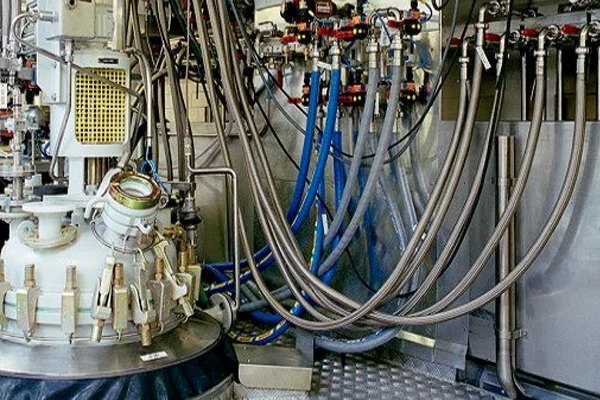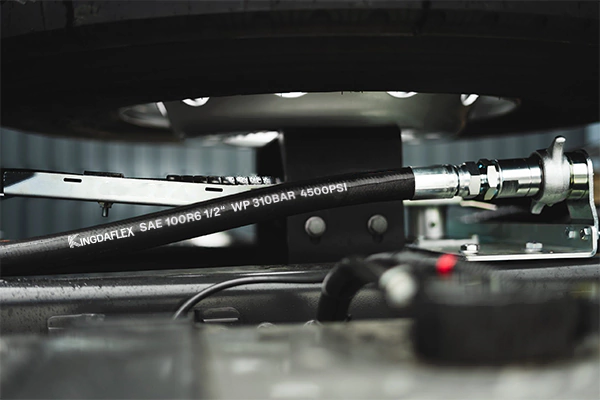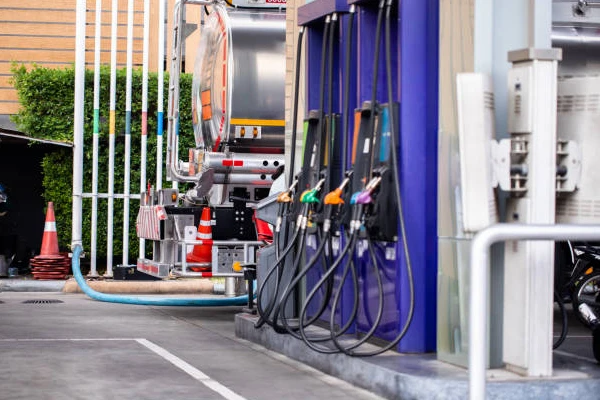When it comes to selecting the right hose for your hydraulic system, the choice often comes down to two primary types: thermoplastic and rubber. While they may appear similar at first glance, their distinct materials and construction lead to significant differences in performance, weight, flexibility, and durability.
Understanding these distinctions is crucial for ensuring the safety, efficiency, and longevity of your equipment. This blog will explore the key differences between thermoplastic and rubber hoses, helping you make an informed decision for your specific application and operating environment.
What is a Thermoplastic Hose?
A thermoplastic hose is a specialized, lightweight, and flexible hose used in hydraulic systems. Unlike traditional rubber hoses that often use steel wire for reinforcement, thermoplastic hoses are constructed from a synthetic polymer inner tube and outer cover, with a reinforcement layer of braided synthetic fibers like polyester or aramid. This design provides a high pressure rating while allowing for a tighter bend radius and a smaller outer diameter.
Thermoplastic hoses are also highly resistant to abrasion, ozone, and many chemicals, and they can be manufactured to be non-conductive, making them a safe choice for applications where electrical hazards are a concern.
- Lightweight and Flexible: The synthetic materials make these hoses significantly lighter and more flexible than rubber alternatives.
- High Pressure Rating: Despite being lightweight, they are engineered to handle high-pressure applications.
- Durable: Their outer covers are highly resistant to abrasion and environmental factors.
- Non-Conductive Options: The absence of metal reinforcement allows for the manufacturing of electrically non-conductive hoses.
- Chemical Resistance: The thermoplastic inner tube is compatible with a wide range of hydraulic fluids.
Thermoplastic Hose Types
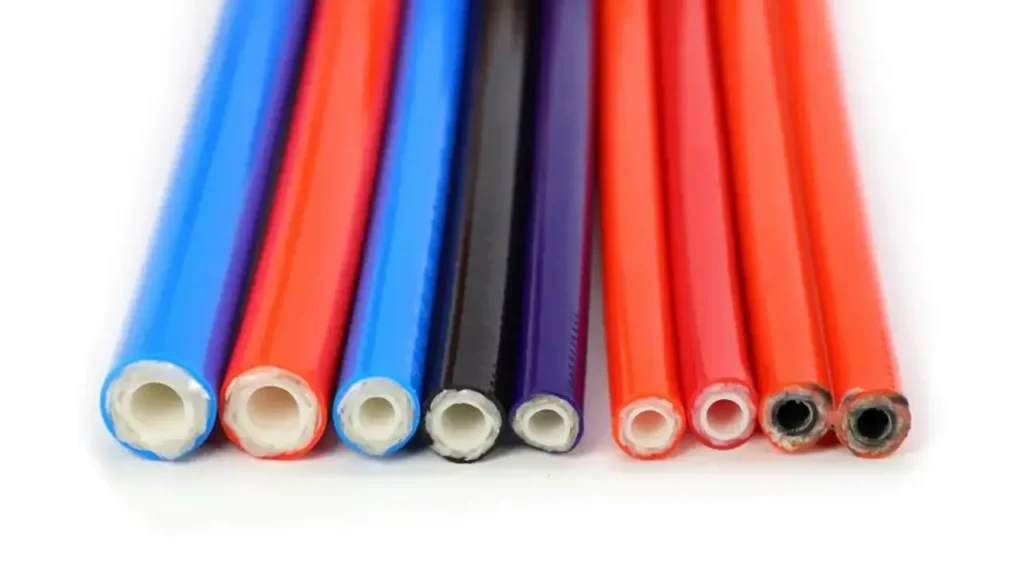
There are several types of thermoplastic hydraulic hoses, which are generally categorized by their pressure rating and construction as defined by the SAE J517 standard. While the standard includes many types of hoses, the most common thermoplastic variations are R7 and R8.
- SAE 100R7 is a medium-pressure thermoplastic hose. It’s designed for applications where electrical non-conductivity is crucial, using a single or double synthetic fiber braid for reinforcement. It’s often used on aerial lifts and cherry pickers.
- SAE 100R8 is a high-pressure thermoplastic hose. It’s built with more robust synthetic fiber reinforcement, often aramid, to handle higher pressures. It’s a lightweight alternative to traditional high-pressure rubber hoses.
- SAE 100R18 is a compact, high-pressure thermoplastic hose. This type offers the same working pressure as 100R8 but with a smaller outer diameter and a tighter bend radius, making it ideal for confined spaces.
What is a Rubber Hose?
A rubber hose is a traditional, flexible fluid conduit widely used in hydraulic systems, defined by its key material—synthetic or natural rubber. Unlike thermoplastic hoses, it is typically reinforced with a woven or braided layer of steel wire, which gives it its strength and pressure rating. This construction provides excellent durability and resistance to high temperatures, making it a reliable choice for heavy-duty applications.
However, the steel reinforcement also makes it heavier and less flexible compared to its thermoplastic counterparts and allows it to conduct static electricity, which can be a safety concern in some environments.
- Materials: Composed of synthetic or natural rubber for the inner tube and outer cover, and reinforced with a steel wire braid or spiral.
- Weight & Flexibility: Generally heavier and less flexible due to the steel wire reinforcement.
- Durability: Highly durable and well-suited for high-temperature and high-pressure applications.
- Conductivity: The steel reinforcement makes the hose electrically conductive, which can be a risk but is also used to ground static electricity.
Rubber Hose Types
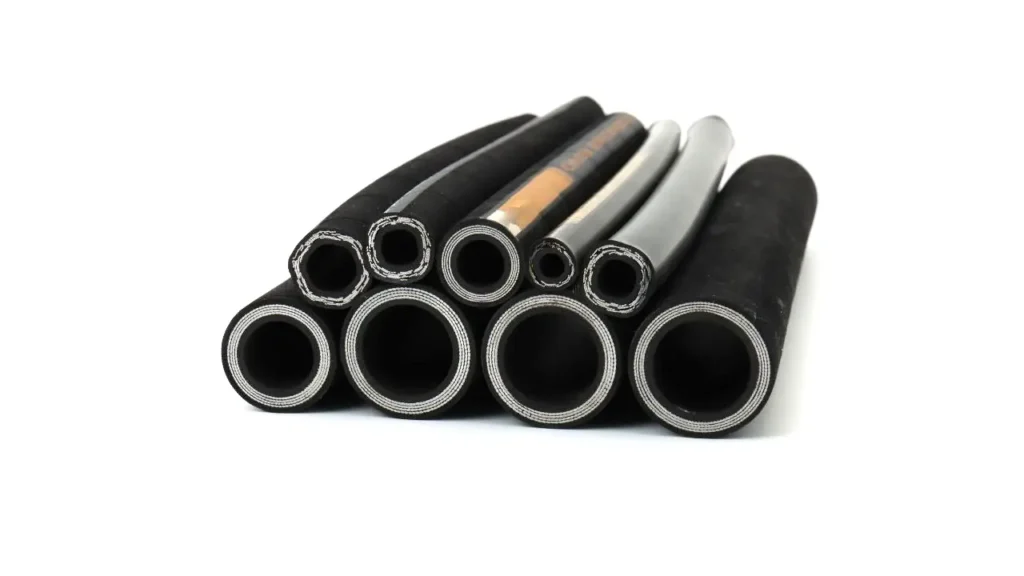
Rubber hoses are a traditional and versatile type of hydraulic hose, commonly categorized by their pressure rating and reinforcement structure as defined by SAE J517 standards. These hoses are built to handle a wide range of pressures and temperatures, making them a staple in heavy-duty applications.
The primary types are distinguished by the number of steel wire braids or spirals used for reinforcement, which directly impacts the hose’s strength, weight, and flexibility.
Here is a list of common types of rubber hoses, categorized by their application and construction.
Rubber Hydraulic Hoses
-
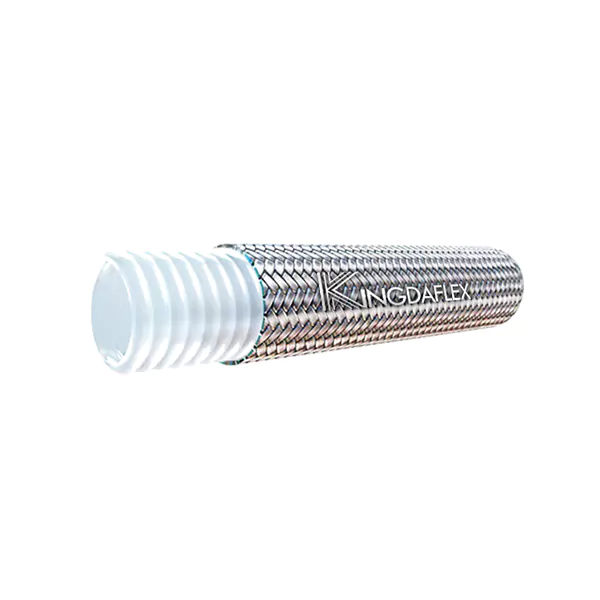 SAE 100R14 / Teflon Hose(Inner Corrugated Tube)
SAE 100R14 / Teflon Hose(Inner Corrugated Tube) -
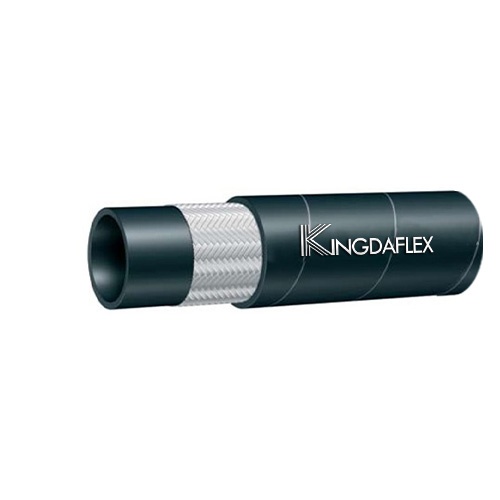 SAE 100R6 | Hydraulic Hose
SAE 100R6 | Hydraulic Hose -
 SAE 100R15 | Hydraulic Hose
SAE 100R15 | Hydraulic Hose -
 SAE 100R13 | Hydraulic Hose
SAE 100R13 | Hydraulic Hose -
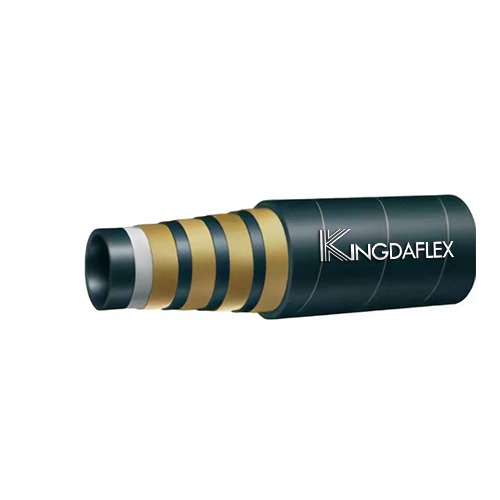 SAE 100R12 | 4 Wire Spiral Hydraulic Hose
SAE 100R12 | 4 Wire Spiral Hydraulic Hose -
 SAE 100R9 | Hydraulic Hose
SAE 100R9 | Hydraulic Hose -
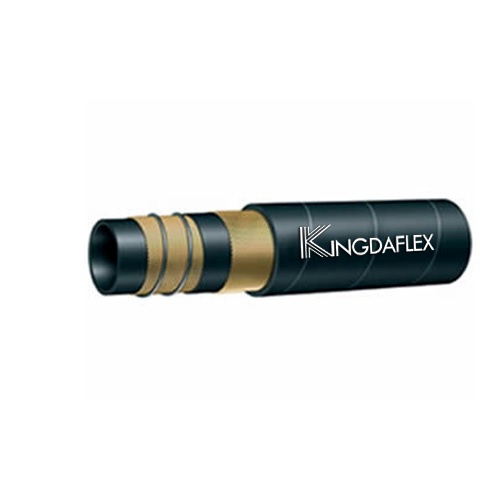 SAE 100R4 | Hydraulic Suction Hose
SAE 100R4 | Hydraulic Suction Hose -
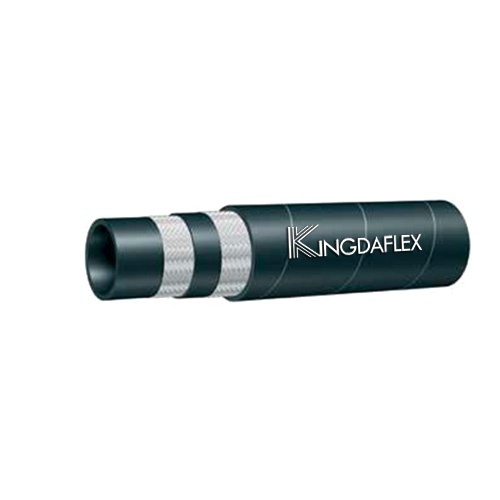 SAE 100R3 Textile Fiber Reinforced Hydraulic Hose
SAE 100R3 Textile Fiber Reinforced Hydraulic Hose -
 SAE 100 R14 / Teflon Hose (Inner Smooth Tube)
SAE 100 R14 / Teflon Hose (Inner Smooth Tube) -
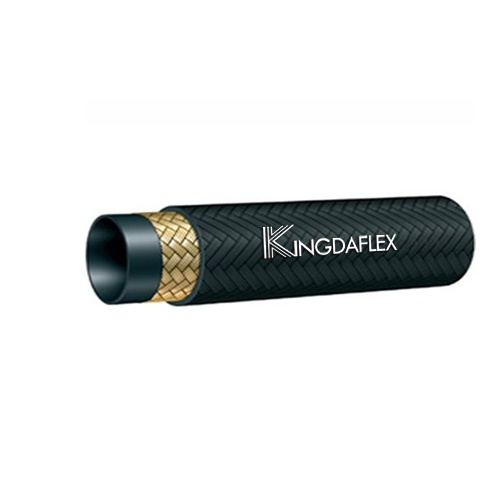 SAE 100R5 | Fabric Covered Hydraulic Hose
SAE 100R5 | Fabric Covered Hydraulic Hose -
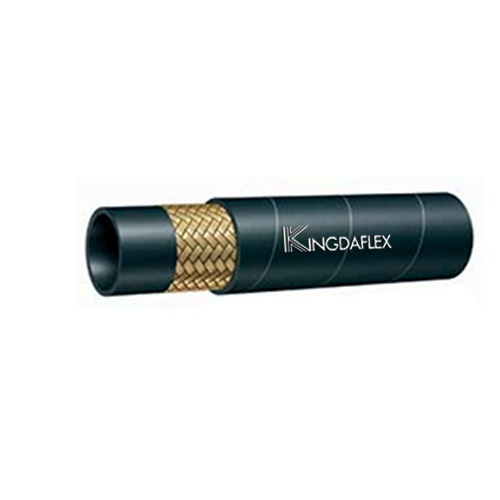 SAE 100R17 | Hydraulic Hose
SAE 100R17 | Hydraulic Hose -
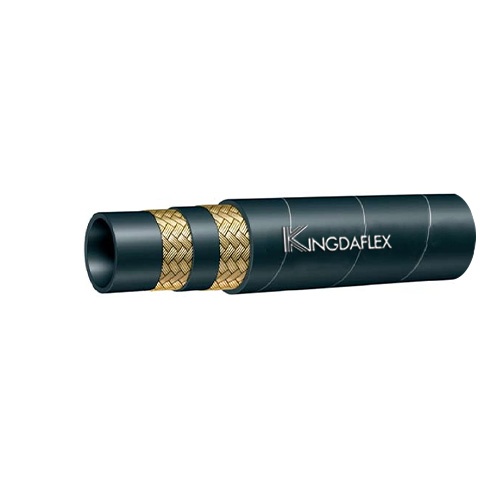 SAE 100R16 | Hydraulic Hose
SAE 100R16 | Hydraulic Hose -
 SAE 100R2A / DIN EN853 2ST
SAE 100R2A / DIN EN853 2ST -
 SAE 100R1A/DIN EN853 1ST
SAE 100R1A/DIN EN853 1ST -
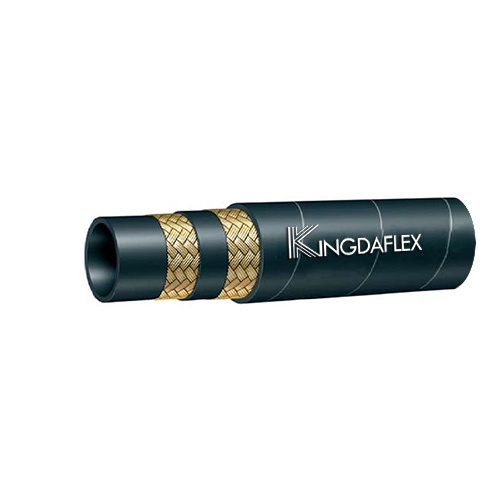 SAE 100R2AT / DIN EN853 2SN
SAE 100R2AT / DIN EN853 2SN -
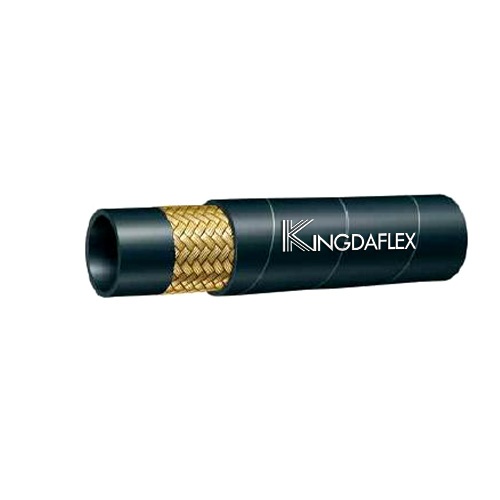 SAE 100R1AT/ DIN EN853 1SN
SAE 100R1AT/ DIN EN853 1SN
These are categorized primarily by the SAE J517 standard and are used to transfer hydraulic fluid under pressure.
- SAE 100R1: A single steel wire braided hose for low to medium-pressure applications.
- SAE 100R2: A two-steel wire braided hose for high-pressure applications.
- SAE 100R4: A specialized spiral-wire reinforced hose for suction and return lines.
- SAE 100R12: A four-spiral steel wire reinforced hose for very high-pressure applications.
- SAE 100R13 & 100R15: These are six-spiral steel wire reinforced hoses for extremely high-pressure, heavy-duty applications.
Industrial Hoses
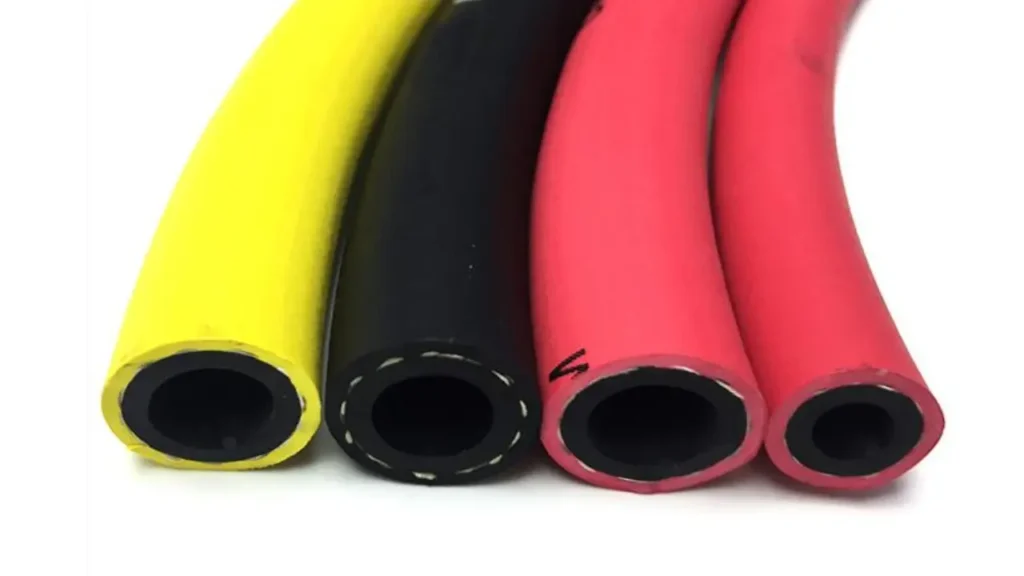
These hoses are designed for a wide range of industrial applications beyond hydraulics.
- Air & Multipurpose Hoses: Used for conveying compressed air or water. They are typically flexible and durable.
- Water Hoses: Designed for transferring hot or cold water, often with high abrasion resistance for industrial or construction use.
- Material Handling Hoses: Used to move abrasive materials like sand, gravel, or cement. They feature a thick, abrasion-resistant inner tube.
- Steam Hoses: Constructed to withstand high-temperature steam in industrial cleaning or processing applications.
- Chemical Hoses: Lined with specialized rubber to be compatible with a wide array of corrosive chemicals, acids, and solvents.
Automotive Hoses
These hoses are specifically engineered for use in vehicles.
- Radiator & Heater Hoses: Made of EPDM rubber to resist high temperatures and transfer coolant.
- Fuel Hoses: Designed to be compatible with gasoline, diesel, and other petroleum-based fuels without degradation.
- Brake Hoses: A key safety component, reinforced to handle the high pressure of brake fluid.
- Air Intake Hoses: Connect the air filter to the engine, designed to be flexible and withstand engine vibrations.
Thermoplastic Hose vs Rubber Hose
Both thermoplastic and rubber hoses are essential for hydraulic systems, but they are built with different materials that give them distinct properties. Choosing between them depends on your specific application’s needs for pressure, weight, flexibility, and environmental resistance.
Material and Construction
A thermoplastic hose is constructed from synthetic polymers and fibers. It features a thermoplastic inner tube and outer cover, with a reinforcement layer made of braided synthetic fibers like polyester or aramid. This design eliminates the need for steel wire, resulting in a significantly lighter and more flexible hose.
A rubber hose, on the other hand, is built using a core of synthetic or natural rubber for both the inner tube and outer cover. Its strength comes from a reinforcement layer of woven or braided steel wire. This traditional construction makes it a very durable choice for high-pressure and high-temperature applications.
Weight and Flexibility
Thermoplastic hoses are remarkably lightweight and highly flexible due to their all-synthetic construction. This makes them easier to handle and install, especially in tight or complex spaces. Their superior flexibility allows for a smaller bend radius, reducing the risk of kinking and making them ideal for dynamic applications.
Conversely, rubber hoses are much heavier and less flexible because of their steel wire reinforcement. While this provides exceptional strength, it makes them more rigid and difficult to route. Their heavier weight can also be a disadvantage in applications where weight is a critical factor, such as in aviation or mobile machinery.
Pressure and Temperature Rating
Rubber hoses are the traditional choice for very high-pressure and high-temperature applications. The steel wire reinforcement provides robust strength, allowing them to withstand extreme pressures and heat without deforming or failing. This makes them a staple in heavy-duty machinery and industrial environments.
Thermoplastic hoses, particularly those meeting the SAE 100R8 standard, can also handle high pressure. While they may not always match the extreme temperature range of certain rubber hoses, they perform exceptionally well in a wide range of temperatures. Their pressure capabilities are tailored to meet the demands of most modern hydraulic systems.
Abrasion and Chemical Resistance
Thermoplastic hoses, particularly those with a polyurethane outer cover, offer superior resistance to abrasion. This tough exterior protects the hose from wear and tear in harsh environments. The thermoplastic inner tube is also resistant to a wide variety of hydraulic fluids, including synthetics and water-based emulsions.
Rubber hoses are durable but may not always have the same level of abrasion resistance as thermoplastic hoses unless they have a specialized outer cover. While they are compatible with many common fluids, their porous nature can lead to fluid permeation over time, and they may be less resistant to certain synthetic fluids and chemicals.
Electrical Conductivity
A key safety difference is electrical conductivity. Rubber hoses, with their steel wire reinforcement, are inherently conductive. They can dissipate static electricity, but they can also pose a risk of electric shock if they come into contact with a high-voltage source.
Thermoplastic hoses, reinforced with synthetic fibers, are electrically non-conductive. This makes them an essential safety component for applications like aerial lifts and utility vehicles where operators are working near power lines. The non-conductive property provides a critical layer of insulation, protecting personnel from electrical hazards.
| Feature | Thermoplastic Hose | Rubber Hose |
| Materials | Thermoplastic polymers and synthetic fibers | Synthetic or natural rubber and steel wire |
| Weight | Very lightweight | Heavier |
| Flexibility | Highly flexible, tighter bend radius | Less flexible, more rigid |
| Abrasion Resistance | Excellent, particularly with polyurethane cover | Good, but can vary |
| Electrical Conductivity | Non-conductive (with synthetic reinforcement) | Conductive (due to steel reinforcement) |
How to Choose Thermoplastic Hose and Rubber Hose?
Choosing between a thermoplastic and a rubber hose requires a careful evaluation of your specific application’s needs. The decision depends on balancing factors like pressure, weight, flexibility, and the operating environment. A thermoplastic hose is the best choice when you need a lightweight, flexible, and often non-conductive solution for medium to high-pressure systems.
Its superior abrasion resistance and chemical compatibility also make it ideal for harsh or specialized environments. Conversely, a rubber hose is a reliable, heavy-duty option for very high-pressure and high-temperature applications where its durability and strength are more critical than its weight or flexibility.
Choosing the Right Hose
- Pressure & Temperature: Choose a rubber hose for the highest pressures and extreme temperatures. For medium to high pressures and a wide temperature range, a thermoplastic hose is suitable.
- Weight & Flexibility: If your application is weight-sensitive or requires tight routing, a thermoplastic hose is the clear winner due to its lightweight and high flexibility.
- Electrical Safety: For applications near power lines, always use a thermoplastic hose with a non-conductive rating to protect against electric shock.
- Abrasion & Environment: Opt for a thermoplastic hose with a polyurethane cover if the hose will be subjected to significant abrasion, chemicals, or UV exposure.
Conclusion
Ultimately, the choice between thermoplastic and rubber hoses hinges on the specific demands of your hydraulic application. While rubber hoses offer a traditional, robust solution for many general-purpose needs, thermoplastic hoses stand out for their specialized benefits, including superior flexibility, lighter weight, and resistance to environmental factors. Making the right choice ensures optimal performance, extends equipment lifespan, and enhances operational safety.
In sum, thermoplastic hoses are the ideal choice for applications where non-conductivity is critical, weight is a concern, or a tight bend radius is required. Their unique construction provides a high-performance alternative to traditional rubber hoses, offering excellent resistance to abrasion and chemicals. This makes them a smart investment for specialized and high-demand systems.
Ready to upgrade your hydraulic system with a superior, cost-effective solution? Look no further. At Kingdaflex, we offer a wide range of high-quality thermoplastic hydraulic hoses. Contact us today to get wholesale thermoplastic hoses that are perfectly tailored to your needs and engineered to the highest standards.




